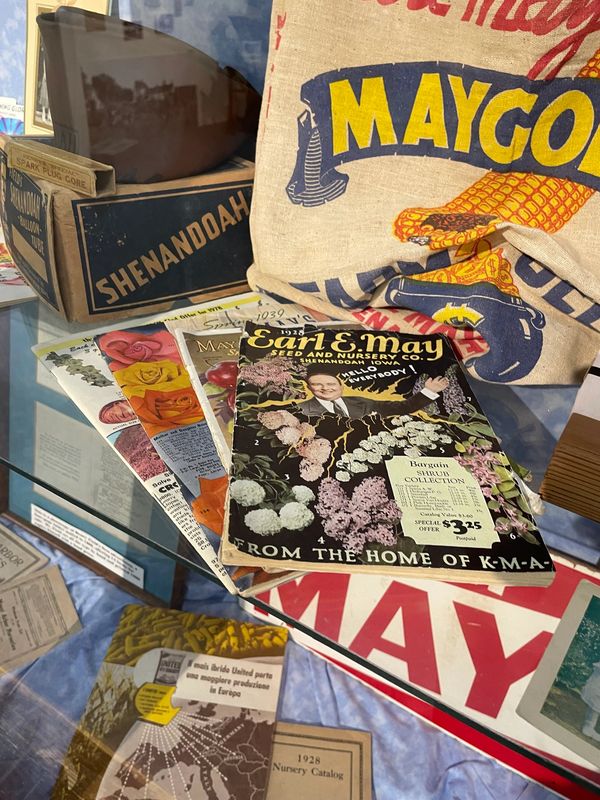Nurseries

Southwestern Iowa is a prime location for nurseries due to its fertile soil, river drainage and ample growing season. By the 1870s several small nurseries were growing staples (such as hedge plans and fruit trees) for pioneer farms in Page and Fremont counties. David S. Lake established his Shenandoah Nursery in 1870, and it soon became the Midwest’s larges producer of apple trees. T.E.B. Mason founded another major nursery, Mount Arbor, just outside Shenandoah in 1875. Around 1892 its namesake started the Henry Field Seed Company here. In 1902 Edward S. Welch of Mount Arbor Nursery helped his brother, J.C. Welch, create Welch’s Nursery. Edward S. Welch also helped his son-in-law, Earl May; organize his own nursery business in 1919.
Each of our nurseries had a main office, mailing and packing buildings, warehouses and cold rooms, which kept live plants dormant. Railroads were important for shipping, and often railroad sidings ran right next to the stockrooms. Employment fluctuated seasonally, peaking during fall harvest and late winter and spring when orders were shipped. Men worked in the fields, while women handled most secretarial, packing and mailing jobs.
Different eras saw different demand for seeds and nursery stock. Pioneers grew fruit trees and hedges to enclose their land. Early in the twentieth century, ornamental plants and evergreens rivaled the production of fruit trees. As demand for nursery stock increased, so did acreage under production in Shenandoah. By the 1950’s garden seeds and some nursery stock were being ground in temperate locations such as California and Washington.
Due to the agricultural nature of the region, seed corn became an important product. Armstrong’s Mammoth Seed Company and Ratekin’s Seed House (two Shenandoah firms) began producing seed corn in the 1880’s. Around 1910 Henry Field began experimenting with hybrid “Mule Corn” and first offered it to his customers in 1922. Earl May followed suit in the 1930’s, selling McNeilly Hybrids and then his own “Maygold” corn in 1949.
As product demand changed, so did the ways our nurseries reached their customers. Mail order catalogs became popular, and orders flooded the Shenandoah post office. In the 1920’s both Henry Field and Earl May started radio stations on which they advertised their products. Their “Jubilees” annually brought masses of consumers to Shenandoah. Field and May both expanded into retail stores in the 1930’s and garden centers in the 1960’s.
Local nurseries prospered for decades until the Great Depression. While all area nurseries survived, Henry Field’s business experienced severe financial difficulties. By 1954 most of these nurseries were still operated by descendents of their founders except for Fields’ and Mount Arbor. Shenandoah Nurseries was absorbed by Mount Arbor in 1976. In 1978 Mount Arbor filed for bankruptcy and then reorganized. In 1983 Henry Field Seed and Nursery Company was bought by AMFAC, Inc. Earl May is the only major retail nursery headquartered in Shenandoah today.
The overall impact of these nurseries and seed houses on western Page and eastern Fremont counties has been immense of the last 130 years. Altogether, their friendly competition and superior nursery products have transformed our area into one of the most prosperous places in Iowa and brought us worldwide renown.
Greater Shenandoah Historical Society
800 West Sheridan Avenue, Shenandoah, Iowa 51601, United States
Copyright © 2025 Greater Shenandoah Historical Society - All Rights Reserved.
Website built by Tori Hopp